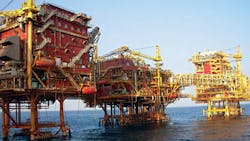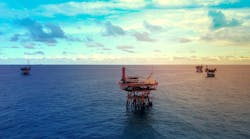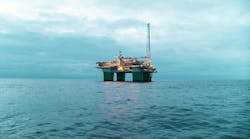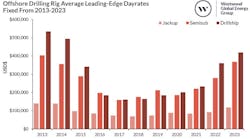Oil & Natural Gas Corp. Ltd. (ONGC) produces oil from the Western Offshore fields off the coast of Mumbai, India. Rather than decommission its fixed, jacket-type platforms dating back to the 1970s, ONGC opted to requalify the structures as fit for extended use. The $150-million project involved the structural assessment of more than 265 platforms, the majority of which had exceeded their 25-year design life. A foremost priority included the identification and delivery of strengthening and mitigation measures for 90% of these platforms, as well as the subsequent recertification necessary to meet industry safety requirements. Structural analyses carried out using SACS and SACS Collapse were integral to ONGC’s methodology for platform life extension/requalification, which added 10-15 years to the structures’ lifespan.
Studies conducted during the analyses included dent modeling, member/joint component strengthening, and additional pile modeling. SACS and SACS Collapse allowed multiple analyses with parametric variations to optimize the strengthening/mitigation measures, all while saving at least 12 resource hours per platform. Each requalification not only ensured uninterrupted oil production, but also avoided installation of a replacement platform at a net cost of $25 million.
A public-sector undertaking of the government of India headquartered in Dehradun, ONGC is a multinational corporation and the country’s largest oil and gas exploration and production company. It began oil exploration and production offshore India in 1976, and today operates 265 fixed platforms in water depths ranging from 25-90 m (82-295 ft). Most of the jacket-type platforms designed for 25 years of service had outlived their design lives. Some platforms underwent modifications to meet changing conditions or to enhance oil recovery, while others were considered noncompliant with Oil Industry Safety Directorate (OISD) requirements.
Taking these aging platforms out of service would cause production losses of up to 1,000 b/d of oil per platform. Instead, ONGC sought to requalify the platforms for another 10-15 years of continuous service. The process involved assessment and mitigation of platforms that were deemed noncompliant or on the verge of noncompliance - an amount of about five platforms per year. Carrying out the structural analyses posed a significant challenge due to the excessive age of the platforms, overstressed structural components, and prior repairs or modifications that altered the original designs. Moreover, the platforms needed to be kept operational, not just to avoid oil production losses but also to accommodate offshore personnel and protect the surrounding marine environment. Safety was of paramount importance.
Iterative optioneering
ONGC selected Bentley’s flexible, interoperable offshore design and analysis applications, SACS and SACS Collapse, integrating a methodology that allowed for multiple analyses of the platforms using parametric variations. By exploring design alternatives for bringing the structures up to current safety standards, the iterative process identified structural weaknesses and optimized the proposed mitigating measures. These measures were as simple as restricting marine growth and removing redundant equipment and appurtenances, or as complex as retrofitting structural components.
Platforms that had sustained damage were assessed using SACS’ dent modeling capability. This time-saving process involved selecting a section of the dented member, then modeling that member to obtain a strength assessment. For the majority of platforms that had inherent structural weaknesses, the company used SACS in conjunction with SACS Collapse, a non-linear collapse analysis application, to determine the primary structural joints and/or members that required strengthening. Joints that were found to be overstressed in the design-level analysis with SACS were then assessed for ultimate strength adequacy using SACS Collapse. Once the failure modes were identified, it was possible to analyze different strengthening options. For joints failing under compression, SACS verified the option of strengthening the joint using infill grout. For joints failing under tension, SACS compared strengthening options using either infill grout or metal clamps. Ease of installation was also considered in the final analysis.
Significant changes in loading also required close scrutiny of the piles, which were subject to failure due to material incapacity or soil overload. Load reduction resolved the issue for some platforms, while others required installation of additional piles. Installing piles on existing platforms had not been previously carried out in the Western Offshore field, so ONGC had to devise the technical approach to pile design, fabrication, installation, and load transference. The load distribution pattern for the new piles considered the weights of the jacket structure and the topsides, as well as the effects of the pile-soil support system. Iterative SACS analyses calculated the optimal pile material, size, and distribution.
Understanding the ultimate behavior of the structural components made it easy to ascertain and mitigate the failure modes of the jacket structures. ONGC’s adoption of an iterative optioneering methodology ensured that each platform had sufficient structural support capacity. The structural analysis revealed that most of the old jacket structures did not meet OISD requirements, primarily due to recent changes in design parameters. Deploying Bentley software to carry out multiple analyses with parametric variations provided ONGC with an effective solution for optimizing the remedial measures.
The interoperability of SACS and SACS Collapse enhanced the team’s ability to efficiently and effectively explore different strengthening/mitigation alternatives, resulting in significant time and cost savings. Specifically, conducting customized, simultaneous analyses in SACS and SACS Collapse saved at least 12 resource hours per platform. For this project, 10 platforms underwent non-linear ultimate strength analysis, saving a total of 120 resource hours valued at about $4,000.
The structural analysis studies carried out using Bentley software ensured continued operation and revenue generation from existing platforms. Strengthening/mitigation measures were completed at considerably less expense than the cost of replacing a platform. Even those platforms that required the installation of additional piles, at an estimated cost of $10-15 million per platform, were requalified for less than the cost of a new $40-million platform. By avoiding the replacement of these platforms, ONGC realized net savings of $25 million per platform.
ONGC’s continued domestic oil production contributes to India’s 40 million metric ton per year production supply, which feeds the country’s demand for 160 million metric ton per year. The requalification and recertification of the offshore jacket structures added 10-15 years of service to each platform, ensuring the continued production of an average of 1,000 b/d of oil per platform.







